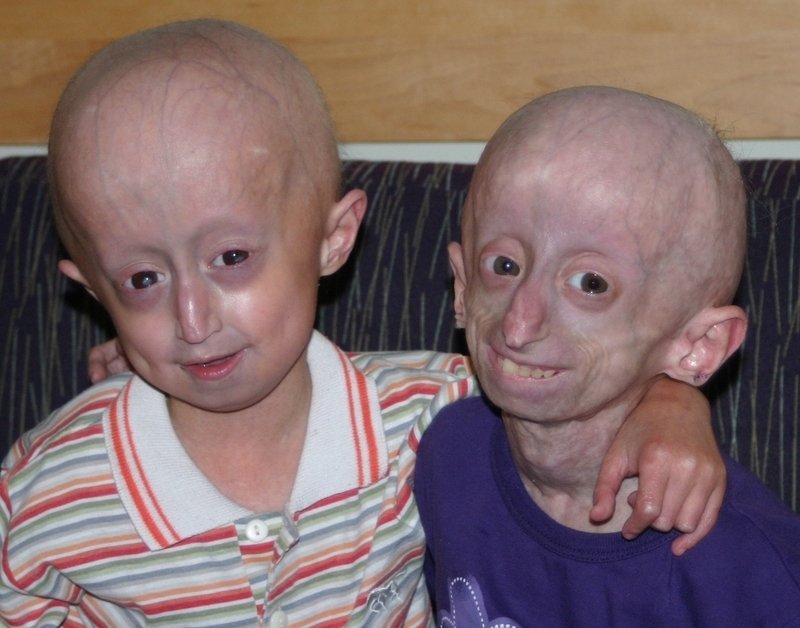Table of Contents
Introduction: A Life Rushing Ahead
Imagine being only ten years old and already dealing with the challenges of aging: joint pain, heart problems, and brittle bones. This is what life looks like for children with Hutchinson-Gilford Progeria Syndrome (HGPS). It’s an extremely rare genetic disease with only about 130 known patients worldwide, and as of now, there is no cure.
Yet despite the odds, many of these children inspire the world with their resilience, positivity, and determination.
What is Hutchinson-Gilford Progeria Syndrome?
Hutchinson-Gilford Progeria Syndrome is a genetic condition that causes rapid aging in children. It is caused by a mutation in the LMNA gene, which produces a protein that helps keep the center of cells (called the nucleus) stable. When the LMNA gene is faulty, it produces an abnormal version of the protein called progerin. This causes cells to break down faster than normal.
Although babies with Progeria are usually born healthy, they begin to show signs of aging between the ages of 1 and 2. These signs are not just cosmetic — they affect nearly every system in the body.

How Progeria Affects the Body
The symptoms of Progeria resemble those of normal aging, but they happen at a much faster rate. Some common features include:
- Growth failure and short stature
- Loss of body fat and muscle
- Hair loss (alopecia)
- Aged-looking skin
- Joint stiffness
- Hip dislocation
- Heart disease (atherosclerosis)
Tragically, the average lifespan for a child with Progeria is around 13 to 15 years, often due to heart attacks or strokes. Despite these medical challenges, their mental development remains normal, and many patients are bright, intelligent, and full of dreams.
Living With Progeria: Stories of Strength and Smiles
Each child living with Progeria has a powerful story to tell. One of the most well-known patients was Sam Berns, a young boy from the United States. Sam became a public speaker, inspired millions through his TED Talk, and was the subject of the documentary “Life According to Sam”. He passed away in 2014 at the age of 17, leaving behind a legacy of hope.
In India, Nihal Bitla helped raise awareness about the condition. Before his passing in 2016, Nihal worked to meet scientists and leaders, always hoping that a cure would be found. His courage and curiosity touched many hearts.
These stories remind us that behind every diagnosis is a real person – a child with dreams, hobbies, and laughter.
130 Known Patients Worldwide: The Rarity of the Disease
Progeria is incredibly rare. There are approximately 130 patients living with the disease around the globe. Most cases are not inherited; they result from a random mutation during the early stages of embryo development.
Because of its rarity, many doctors may never see a case during their entire medical career. This makes awareness, early diagnosis, and international collaboration all the more important.

Is There a Cure? Hope Through Science
Currently, there is no known cure for Hutchinson-Gilford Progeria Syndrome. However, research has made progress. In 2020, the U.S. FDA approved Zokinvy (lonafarnib), the first treatment designed specifically for Progeria. While it is not a cure, studies show that Zokinvy can extend a patient’s life by an average of 2.5 years.
Research is also being done on gene therapy and treatments that could target the production of progerin. Scientists are hopeful that continued study may lead to more effective solutions in the near future.

The Power of Awareness and Research
One of the biggest challenges facing Progeria is lack of public awareness. Because the disease affects so few people, it often receives less funding and research attention than more common illnesses.
Organizations like the Progeria Research Foundation are doing important work to support families, spread information, and fund scientific studies. Public support — whether through donations, events, or simply sharing stories — plays a critical role in keeping the momentum going.

Case of a 4-Year-Old Boy with HGPS Complicated by Stroke
One particularly challenging case involved a 4-year-old boy who exhibited severe growth retardation and distinctive facial features typical of HGPS. His condition was further complicated by neurological symptoms, including blurred vision and communication difficulties. Medical imaging revealed multiple abnormalities: bilateral internal carotid artery stenosis, cranial suture anomalies, and signs of cerebral infarction. These findings underscored the aggressive nature of vascular complications in HGPS, highlighting the need for early detection and comprehensive management strategies
Conclusion: Why Every Voice Matters
Hutchinson-Gilford Progeria Syndrome may be rare, but its impact is enormous. It teaches us about resilience, the power of science, and the importance of compassion.
Behind the numbers are brave children and families who wake up every day fighting a battle that most of us can’t imagine. They deserve not just our sympathy, but our action.
Share their stories. Support their research. Speak their names. Because sometimes, the smallest voices carry the loudest messages.
“We can’t cure aging yet, but we can chase hope.”
Let us chase it together.
To read about the longest survivor of HGPS click here.












Leave a comment